For Whom the Bell Tolls (film)
| For Whom the Bell Tolls | |
|---|---|
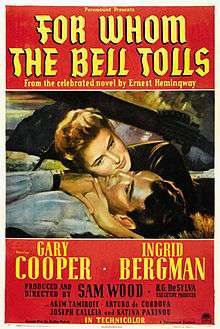 Theatrical release poster | |
| Directed by | Sam Wood |
| Produced by | Sam Wood |
| Screenplay by | Dudley Nichols |
| Based on |
For Whom the Bell Tolls by Ernest Hemingway |
| Starring | |
| Music by | Victor Young |
| Cinematography | Ray Rennahan |
| Edited by |
|
Production company | |
| Distributed by | Paramount Pictures |
Release dates |
|
Running time | 170 minutes (19 reels) |
| Country | United States |
| Language | English |
| Box office | $7.1 million (est. US/ Canada rentals)[1][2] |
For Whom the Bell Tolls is a 1943 American war film produced and directed by Sam Wood and starring Gary Cooper, Ingrid Bergman, Akim Tamiroff, and Joseph Calleia. The screenwriter Dudley Nichols based his script on the 1940 novel For Whom the Bell Tolls by American novelist Ernest Hemingway. The film is about an American International Brigades volunteer, Robert Jordan (Cooper), who is fighting in the Spanish Civil War against the fascists. During his desperate mission to blow up a strategically important bridge to protect Republican forces, Jordan falls in love with a young woman guerrilla fighter (Bergman).
For Whom the Bell Tolls was Ingrid Bergman's first Technicolor film. Hemingway handpicked Cooper and Bergman for their roles. The film became the top box-office hit of 1943, earning $7.1 million. It was also nominated for nine Academy Awards, winning one. Victor Young's film soundtrack for the film was the first complete score from an American film to be issued on record.[3]
Plot
During the Spanish Civil War, an American language teacher, Robert Jordan (Gary Cooper), who lived in Spain during the pre-war period, fights in the International Brigades against Francisco Franco's forces. An experienced dynamiter, Jordan is ordered to travel behind enemy lines and destroy a critical bridge with the aid of a band of local anti-fascist guerrillas. The bridge must be blown up to prevent enemy troops from traveling across it to respond to an upcoming offensive against the fascists.
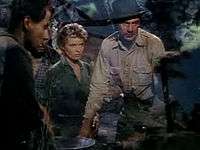
Jordan meets an old man, Anselmo, who is a guerrilla fighter who will serve as Jordan's liaison with the local guerrilla fighters. Anselmo leads Jordan to a group of Republican guerrillas who are led by a middle-aged man named Pablo. Jordan falls in love one of the guerrillas, a young woman named María. María's life was shattered by her parents' execution and her gang-rape at the hands of the Falangists (part of the fascist coalition) at the outbreak of the war. Jordan has a strong sense of duty, which clashes with the unwillingness of the guerrilla leader Pablo to commit to helping with the bridge-blowing operation, as it would endanger himself and his band. At the same time, Jordan develops a new-found lust for life which arises from his love for María. Pablo's common-law wife, Pilar, usurps Pablo's leadership and pledges the allegiance of the guerrillas to Jordan's mission. However, when another band of anti-fascist guerrillas, led by El Sordo, is surrounded and killed in a desperate last stand, Pablo destroys Jordan's dynamite detonation equipment, hoping to prevent the bridge demolition and thereby avoid fascist reprisals on his camp. Later, Pablo regrets abandoning his comrades and returns to assist in the operation.
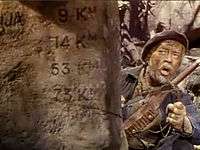
However, the enemy, apprised of the coming offensive, has prepared to ambush the Republicans in force and it seems unlikely that blowing up the bridge will do much to prevent a rout. Regardless, Jordan understands that he must still demolish the bridge in an attempt to prevent fascist reinforcements from overwhelming his allies. Lacking the equipment destroyed by Pablo, Jordan and Anselmo improvise an alternative method to explode the dynamite by using hand grenades. Jordan attaches wires to the grenades so that their pins can be pulled from a distance. This improvised plan is considerably more dangerous than using conventional detonators, because the men must increase their proximity to the explosion.
While the guerrilla fighters—Pablo, Pilar, and María—create a diversion for Jordan and Anselmo, the two men plant and detonate the dynamite, costing Anselmo his life when he is hit by a piece of debris from the exploding bridge. While the guerrillas are escaping on horseback, Jordan is maimed when a fascist tank shoots his horse out from under him. Jordan cannot feel his legs and he knows that if his comrades stop to rescue him, they too will be captured or killed. He bids goodbye to María and ensures that she escapes to safety with the surviving guerrillas. Armed with a Lewis machine gun, he waits until the horse-mounded fascist soldiers appear in his gun sights. He then pulls the trigger, firing a sweeping barrage at the oncoming soldiers. The film ends with Jordan firing the Lewis gun directly at the camera.
Cast
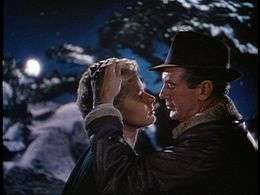
- Gary Cooper as Robert Jordan
- Ingrid Bergman as María
- Akim Tamiroff as Pablo
- Arturo de Córdova as Agustín
- Vladimir Sokoloff as Anselmo, the guide
- Mikhail Rasumny as Rafael, the gypsy
- Fortunio Bonanova as Fernando
- Eric Feldary as Andrés, the courier
- Victor Varconi as Primitivo, the lookout
- Joseph Calleia as El Sordo
- Lilo Yarson as Joaquin
- Katina Paxinou as Pilar
- Alexander Granach as Paco
- Adia Kuznetzoff as Gustavo
- Leonid Snegoff as Ignacio
- Leo Bulgakov as General Golz
- Duncan Renaldo as Lieutenant Berrendo
- Frank Puglia as Captain Gomez
- Pedro de Cordoba as Colonel Miranda
- Michael Visaroff as Staff Officer
- Martin Garralaga as Captain Mora
- Jean Del Val as The Sniper
- John Mylong as Colonel Duval
Restoration
The film was originally released in a roadshow format, at 170 minutes (not counting intermission). For re-release, it was trimmed to 134 minutes, and it was not seen at its full length until the late 1990s, when it was archivally restored to 168 minutes. This restored version is the one that has been released on DVD. The restoration was photochemical, not digital, and the titles and some of the scenes in the early reels are slightly to significantly out-of-register.
Accolades
Academy Awards
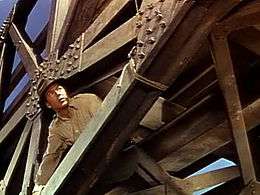
- Best Actress in a Supporting Role: Katina Paxinou
- Nominations
- Outstanding Motion Picture: Paramount
- Best Actor: Gary Cooper
- Best Actress: Ingrid Bergman
- Best Actor in a Supporting Role: Akim Tamiroff
- Best Cinematography (Color): Ray Rennahan
- Best Art Direction (Color): Art Direction: Hans Dreier, Haldane Douglas; Interior Decoration: Bertram Granger
- Best Film Editing: Sherman Todd, John F. Link Sr.
- Best Music (Music Score of a Dramatic or Comedy Picture): Victor Young
Others
The film is recognized by American Film Institute in these lists:
- 2002: AFI's 100 Years...100 Passions – Nominated[6]
- 2005: AFI's 100 Years...100 Movie Quotes:
- Maria: "I do not know how to kiss, or I would kiss you. Where do the noses go?" – Nominated[7]
- 2005: AFI's 100 Years of Film Scores – Nominated[8]
Other versions
There was a Lux Radio Theater version broadcast on February 11, 1945, which retained the principal cast from the film: Gary Cooper, Ingrid Bergman, and Akim Tamiroff.
See also
References
- ↑ "All Time Domestic Champs", Variety, 6 January 1960 p 34
- ↑ "Top Grossers of the Season", Variety, 5 January 1944 p 54
- ↑ Patrick Robinson. 1980. Movie Facts and Feats: A Guinness Record Book.
- ↑ "The 16th Academy Awards (1943) Nominees and Winners". Academy of Motion Picture Arts and Sciences. Retrieved 2014-02-27.
- ↑ "NY Times: For Whom the Bell Tolls". NY Times. Retrieved 2008-12-16.
- ↑ "AFI's 100 Years...100 Passions Nominees" (PDF). Retrieved 2016-08-19.
- ↑ "AFI's 100 Years...100 Movie Quotes Nominees" (PDF). Retrieved 2016-08-19.
- ↑ "AFI's 100 Years of Film Scores Nominees" (PDF). Retrieved 2016-08-19.
External links
| Wikimedia Commons has media related to For Whom the Bell Tolls (film). |
- For Whom the Bell Tolls at the American Film Institute Catalog
- For Whom the Bell Tolls at the Internet Movie Database
- For Whom the Bell Tolls at AllMovie
- For Whom the Bell Tolls at the TCM Movie Database
Streaming audio
- Radio adaptation of For Whom The Bell Tolls February 12, 1945 on Lux Radio Theatre; 50 minutes, with the original stars (MP3)